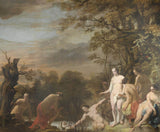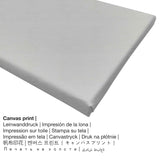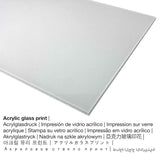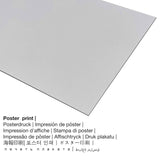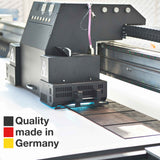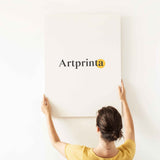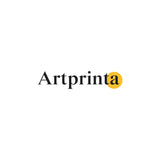Ferdinand Bol, 1660 - Ada Fero chọtara Moses na Basket Rush - ọmarịcha nka.
Ụtụ gụnyere. Mbupu gbakọrọ na ndenye ọpụpụ.
In 1660 Ferdinand Bol mere mpempe nka a na-akpọ "Pharoah's Daughter Discovers Moses in the Rush Basket". Kedu ihe ọzọ, enwere ike ilele ihe osise na n'ime Rijksmuseum's digital collection dị na Amsterdam, Netherlands. We are delighted to state that the masterpiece, which is in the ngalaba ọha a na-enye ya site n'ikike nke Rijksmuseum.Ọzọkwa, ọrụ nka nwere akara kredit a: . Ọzọkwa, alignment bụ odida obodo na a akụkụ ruru nke 1.2: 1, nke pụtara na ogologo bụ 20% ogologo karịa obosara. Ferdinand Bol was a painter, etcher of Dutch nationality, whose artistic style can primarily be assigned to Baroque. The European artist lived for a total of 64 years and was born in the year 1616 in Dordrecht, South Holland, Netherlands and died in the year 1680 in Amsterdam, North Holland, Netherlands.
Ngwaahịa anyị na-enye:
Nchịkọta nhọrọ ngwaahịa na-enye gị ohere ịhọrọ ngwa na nha nke gị. Nha na ihe ndị a bụ nhọrọ anyị na-enye gị maka nkeonwe:
- Ugogbe acrylic ebipụtara: An acrylic glass print, often denoted as a UV print on plexiglass, makes the original into stunning décor. Your artwork is custom-made with the help of modern UV print technology. The special effect of this are rich and stunning colors.
- Mbipụta nke aluminom: These are metal prints on alu dibond with an impressive effect of depth.
- Ebipụta akwụkwọ mmado na ihe akwa akwa: A poster print is a printed canvas paper with a slightly rough surface texture. A poster is designed for placing your fine art print with a personal frame. Please note, that depending on the absolute size of the poster we add a white margin between 2-6cm around the artwork to facilitate the framing with your custom frame.
- Mbipụta kwaaji: The printed canvas, not to be confused with a canvas painting, is a digital copy applied directly on canvas. Further, a canvas print makes a lively, pleasing appearance. A canvas print of this masterpiece will let you turn your very own into a large work of art. Hanging a canvas print: The advantage of canvas prints is that they are relatively low in weight, meaning that it is quite simple to hang up your Canvas print without the support of additional wall-mounts. That is why, a canvas print is suited for all types of walls.
Disclaimer: We try our utmost to depict our products as closely as possible and to showcase them visually on the product detail pages. Although, the tone of the print materials, as well as the printing can differ slightly from the image on your monitor. Depending on the screen settings and the condition of the surface, color pigments can unfortunately not be printed 100% realistically. Because the are printed and processed manually, there may as well be minor variations in the motif's size and exact position.
Ngwaahịa a
| Nkewa edemede: | nka nka |
| Mmeputakwa: | dijitalụ mmeputakwa |
| Usoro mmepụta: | Mbipụta UV ozugbo |
| Nlụpụta: | German mere |
| Ụdị ngwaahịa: | na mmepụta ihe |
| Eji ngwaahịa a chọrọ: | ụlọ mmepụta ihe nka, foto mgbidi |
| Nhazi nka nka: | usoro odida obodo |
| Oke akụkụ onyonyo: | (ogologo: obosara) 1.2: 1 |
| Ntụgharị nkọwa akụkụ onyonyo: | ogologo bụ 20% ogologo karịa obosara |
| Nhọrọ akụrụngwa: | ígwè obibi akwụkwọ (aluminium dibond), ebipụta canvas, mbipụta akwụkwọ mmado (akwụkwọ kwaaji), mbipụta iko acrylic (nwere ezigbo mkpuchi iko) |
| Kanvas n'elu etiti ihe ndọtị (mbipụta akwa akwa): | 60x50cm - 24x20", 120x100cm - 47x39" |
| Mbipụta iko acrylic (nke nwere ezigbo mkpuchi iko): | 60x50cm - 24x20", 120x100cm - 47x39" |
| Ụdị akwụkwọ mmado (akwụkwọ kwaaji) dị iche iche: | 60x50cm - 24x20", 120x100cm - 47x39" |
| Ụdị mbipụta aluminom: | 60x50cm - 24x20", 120x100cm - 47x39" |
| Nhazi nke nnomi nka: | agunyeghi |
Ozi ọrụ nka
| Aha eserese: | "Pharoah's Daughter Discovers Moses in the Rush Basket" |
| Nhazi nka: | sere |
| Category: | nka ochie |
| Century: | 17th narị afọ |
| Emepụtara n'afọ: | 1660 |
| Afọ nka: | ihe karịrị afọ 360 |
| Ụlọ ihe ngosi nka: | Rijksmuseum |
| Ebe ngosi nka: | Amsterdam, Netherlands |
| website: | www.rijksmuseum.nl |
| Ụdị ikike nka: | ngalaba ọha |
| Site n'aka: | Rijksmuseum |
Tebụl metadata omenkà
| Ihe nkiri: | Ferdinand Bol |
| Aha nka ndị ọzọ: | bol ferdinand, Mre. De Ferd. Bol., Ferdinand Pol, Ferdinandus Bol, Ferd Bole, בול פרדיננד, Ferdinand Bool, T. Bol, bol f., Fer. Bol, Ferdinard Boll, Ferdinand Ball, Ferdinando Bool, F. Boll, Fr. Bol, J. Boll, Francis Ball, Ferdinand Bull, bol ferd., Bol, F. Bol, Pool Ferdinand, Ferd. Boll, Pool, Ferdinand Bole, Frances Bolls, Ferd. Bol, Pol, Fradinand Bol, Fradi[nand] Bol, Boll, Ferdinandus Boll, Ferdinand-Bol, P. Bol, F. Ball, Ferdinand Bol, ferd. bool, Ferdinand Balle, F. Bols, F.Bol, Ferdinand Boll, Ferdin. Boll, Bol Ferdinand, François Bool, F: Bol |
| okike onye nka: | nwoke |
| Obodo onye nka: | Dutch |
| Ọrụ onye na-ese ihe: | etcher, onye ese |
| Mba onye si: | mba netherland |
| nhazi ọkwa: | nna ukwu ochie |
| styles: | Baroque |
| Afọ ọnwụ: | 64 afọ |
| Afọ amụrụ: | 1616 |
| Ebe amụrụ onye: | Dordrecht, South Holland, Netherlands |
| Afọ ọnwụ: | 1680 |
| Nwuru na (ebe): | Amsterdam, North Holland, Netherlands |
© Nwebiisinka nke | Artprinta.com
Ozi mgbakwunye si Rijksmuseum (© nwebiisinka - Rijksmuseum - www.rijksmuseum.nl)
The finding of Moses. Pharaoh's daughter found Moses in the bulrush basket. The daughter of the Pharaoh with her companions, including a black woman, at the waterfront bathing. Two women fishing basket from the water. Part of a group of five works produced for the house at 6 Nieuwegracht Utrecht.

